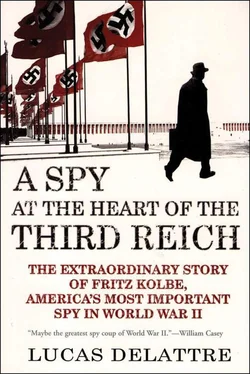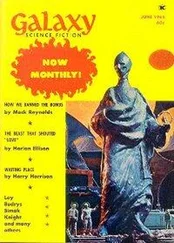He introduced himself: “Despite my Protestant background, we became good friends.” “Course of Life.”
“crimes of the Nazis?”: Clemens August von Galen (1878–1946), bishop of Münster, protested vigorously against the euthanasia measures implemented by the Nazi regime in three public sermons (July–August 1941). This public intervention brought about a halt to the program of extermination of the mentally and physically handicapped.
“one reason or another”: The prelate is supposed to have spoken the following words to Fritz: “It has nothing to do with high treason when you break your word given to a criminal.” “Course of Life.” “Prälat Schreiber… had confirmed [Fritz] by declaring him free of an oath to Hitler,” explains Ernst Kocherthaler in “The Background of the George Story” (1964, personal archives of Fritz Kolbe, Peter Kolbe collection, Sydney). At the time of this conversation with Georg Schreiber, Fritz Kolbe had the intention of fleeing Germany by using a network of smugglers across the Swiss border. Autobiographical document, May 15, 1945.
in Germany’s best interests: In May 1943, an internal circular from Ribbentrop warned the members of the Foreign Ministry that “any defeatist language will be severely punished.” Officials were called on to give an example and not influence “public opinion” ( Volksstimmung ) negatively. Source: Foreign Ministry.
was never carried out: Biographical document by Gerald Mayer and Fritz Kolbe.
him by a friend: Morgan, “The Spy the Nazis Missed.”
to go to Switzerland: Autobiographical document written by Fritz Kolbe in Berlin in early January 1947; personal archives of Fritz Kolbe, Peter Kolbe collection, Sydney.
the middle of 1942: One of the best-informed figures in the Reich was without any doubt the chief of foreign intelligence for the SS, Walter Schellenberg. In early August 1942, Schellenberg was seized by a great sense of uncertainty. At a meeting with his boss Heinrich Himmler in Zhytomyr, Ukraine, he offered to work for a separate peace with the Western powers, a solution that would enable Germany to maintain its conquests without weakening itself further. Himmler gave him a free hand to sound out the Western powers on condition that he spoke to no one about it. He explained that if word of this conversation reached the führer’s ears, he would deny everything and would not “cover” him. Walter Schellenberg, Mémoires (Paris, 1957).
of his own country: “How to get rid of the Nazis? I was of the opinion that there was only one way to get there: the defeat of Germany,” Fritz wrote in the autobiographical document of May 15, 1945. “Wood’s opinion is that we should continue the fight until a definite military decision against the present gang is obtained. He says there is no hope of any effective action being taken by opposition groups.” “Wood’s oral report,” OSS Bern message to Washington, April 12, 1944, National Archives.
yet heard of Goerdeler: Carl Friedrich Goerdeler (1884–1945), along with Ludwig Beck, was one of the principal figures in the German resistance. A former mayor of Leipzig, he would have become head of government if the July 20, 1944 putsch had succeeded. But the failure of the attempt against Hitler signed his death warrant. He was executed on February 2, 1945 at the Plötzensee prison in Berlin.
of the Kreisau Circle: The Kreisau Circle ( Kreisauer Kreis ) took its name from the meeting place for a group of opponents of the Nazi regime around Helmuth James von Moltke, who owned a large estate in Kreisau in Lower Silesia (now Krzyzowa in Poland).
perfectly ordinary passenger train: Source: Alfred Gottwalt, curator for railroads at the Technical Museum in Berlin.
“combined into a whole”: Letter from Vincent Van Gogh to his brother Theo, April 1882.
plotted here and there: A core of conspirators around General Hans Oster had been very active since 1938 in the Abwehr, the military intelligence service headed by Admiral Canaris. In the army, networks were taking steps to eliminate Hitler. In March 1943, a bomb concealed in the führer’s plane flying from Smolensk to Berlin did not explode because of a defect in the detonator. A few days later in Berlin, Hitler left an exhibition early where a young officer loaded with explosives had planned to blow himself up in his presence. Another network, the “Red Orchestra” ( Rote Kapelle ), which was working for Moscow, had been brutally dismantled in late 1942. Its leaders had been executed by hanging in the Plötzensee prison in Berlin in December 1942. In February 1943, a group of young students in Munich (the “White Rose”) had been arrested and all its members executed for distributing leaflets calling on the German people to overthrow the regime.
without shivering in fear: The information about the gong used during air raids comes from the archives of the Foreign Ministry. In offensive terms, Allied aviation was really operational only from late 1942 on. Beginning in early 1943, American and British planes relentlessly dropped their loads of bombs on German cities (the former in broad daylight, the latter at night). This massive deluge affected first of all the large metropolises of the Ruhr, then the rest of the country as far as Berlin. Berlin was hit for the first time in mid-January 1943. Fritz Kolbe, like all Foreign Ministry diplomats, was instructed to place a container of water in the cabinets where he kept his documents. In case of fire, water vapor was supposed to protect papers from burning (archives of the Foreign Ministry). After each attack, there were special distributions of food and an improvement in rations (cigarettes, coffee, meat).
ever, one for hesitation: On February 2, 1943, the Germans were beaten at Stalingrad; this spectacular defeat marked a turning point. The Soviet victory at Stalingrad, three months after the British victory at El Alamein, seemed to herald the end of German advances. Paradoxically, the fighting energy of the Nazi regime was strengthened. They had now entered into “total war” (the expression used by Joseph Goebbels at a rally at the Sports Palace in Berlin on February 18, 1943). No longer able to win major successes on the military fronts abroad, the murderous energy of the Nazis turned inward: the culmination of the deportations of the Jews of the Reich took place in the spring of 1943.
1942 or early 1943: Biographical document by Gerald Mayer and Fritz Kolbe.
“to the Hitler regime”: Autobiographical document, May 15, 1945.
completely trusted each other: Kolbe mentions Karl Dumont in most of the autobiographical documents written after the war.
Waldersee at Professor Sauerbruch’s: Alfred Graf von Waldersee (1898–1984) was a reserve officer in the Wehrmacht. He had been attached to military headquarters in France and then in Stalingrad (from which he had been evacuated after being wounded in 1942). In civilian life, he was an industrialist and businessman. His mother’s family, the Haniels, owned large coal mines in the Ruhr. In April 1944, he became director of Franz Haniel & Kompanie GmbH (coal merchants and river transport). His wife was Baroness Etta von le Fort (1902–78), who had joined the Red Cross at the beginning of the Second World War. Source: Dr. Bernhard Weber-Brosamer (Franz Haniel & Kompanie, Duisburg).
Читать дальше











